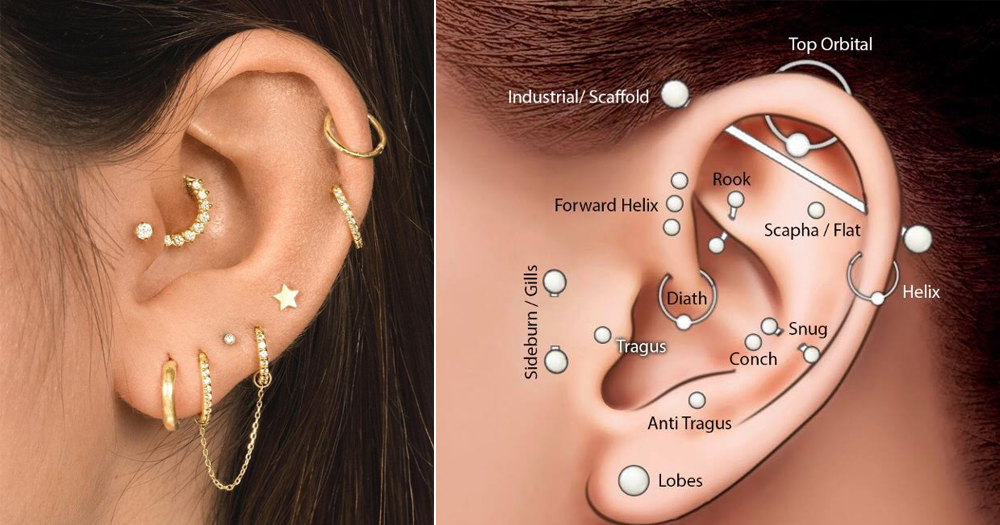Ear piercings have remained a popular form of body art and self-expression across generations and cultures. Whether it’s your first piercing or your tenth, knowing what to expect in terms of pain is essential. This is where the ear piercing pain chart becomes incredibly useful. It helps you understand which areas might hurt more and how long each piercing typically takes to heal. In this guide, we’ll explore the anatomy of the ear, pain factors, detailed breakdowns of each piercing type, and how to choose the right one for you.
Understanding the Anatomy of the Ear
Before diving into the ear piercing pain chart, it’s important to understand the basic anatomy of the ear. The ear is composed of three main sections: the lobe, the outer cartilage, and the inner cartilage.
- Lobe: The softest and fleshiest part of the ear, located at the bottom. This area heals quickly and is generally the least painful to pierce.
- Outer Cartilage: Includes areas such as the helix and forward helix. These parts are firmer and may cause moderate pain during piercing.
- Inner Cartilage: Areas like the tragus, rook, conch, and daith. These zones are often thicker, making them more painful and slower to heal.
Understanding where you want your piercing helps set expectations about the level of pain and care required.
What Affects Piercing Pain Levels?
Not everyone experiences pain the same way. Several factors influence how painful a piercing might be:
- Personal Pain Tolerance: Everyone has a different threshold for pain, which significantly impacts the perceived discomfort.
- Piercing Technique: A skilled professional using a needle rather than a piercing gun can make a huge difference.
- Anxiety or Stress: Nervousness may heighten your pain perception.
- Healing Ability: Those with good immune responses may heal faster and experience less lingering pain.
Overview of the Ear Piercing Pain Chart
The ear piercing pain chart categorizes various types of ear piercings by their typical pain levels and healing times. The following table gives you a quick overview:
| Piercing Type | Pain Level (1-10) | Healing Time | Description |
|---|---|---|---|
| Earlobe | 1–2 | 4–6 weeks | Soft tissue, least painful |
| Upper Lobe | 2–3 | 6–8 weeks | Slightly higher than lobe, still mild |
| Helix | 4–5 | 3–6 months | Outer cartilage, moderate pain |
| Forward Helix | 5–6 | 3–9 months | Front upper ear, can be sensitive |
| Tragus | 5–6 | 3–8 months | Small flap near ear canal, thicker area |
| Daith | 6–7 | 4–9 months | Inner cartilage, rumored migraine relief |
| Conch | 6–7 | 4–10 months | Inner shell of ear, deeper cartilage |
| Rook | 7–8 | 6–9 months | Thick cartilage ridge, intense pain |
| Snug | 8 | 8–12 months | Inner rim, very thick and painful |
| Industrial | 8–9 | 9–12 months | Dual cartilage piercings, higher pain |
Detailed Piercing Breakdown
Let’s now go deeper into each type of ear piercing and examine their respective pain levels, healing expectations, and ideal care methods.
Earlobe Piercing
The earlobe piercing is by far the most common and beginner-friendly option. It involves the soft, fleshy bottom of the ear, making it the least painful according to the ear piercing pain chart. Most people report just a slight pinch, and healing is relatively fast—typically around 4 to 6 weeks. With minimal aftercare, this piercing is often the first choice for children and adults alike.
Upper Lobe Piercing
The upper lobe is just above the traditional lobe piercing. The pain is only slightly more noticeable, and healing takes around 6 to 8 weeks. This piercing offers more style variety without venturing into cartilage territory.
Helix Piercing
Located on the upper outer edge of the ear, the helix is a popular cartilage piercing. The ear piercing pain chart places it at a 4–5 out of 10 in terms of pain. While not unbearable, it can be more sensitive than the lobe due to the cartilage. Healing can take several months, and it’s crucial to avoid sleeping on the pierced side.
Forward Helix Piercing
This variation is on the front-facing part of the helix. Pain levels are moderately higher—typically 5–6 on the chart—due to limited space and more nerves in this area. Healing can take up to 9 months, especially if the area is disturbed often.
Tragus Piercing
The tragus is the small, thick flap in front of the ear canal. This cartilage area can be more difficult to pierce and usually ranks 5–6 in pain level. Healing takes around 3 to 8 months. People with smaller tragus structures may find this piercing more challenging.
Daith Piercing
A daith piercing goes through the inner fold of cartilage just above the ear canal. It’s rated between 6–7 on the pain chart due to the thickness of the tissue. Some claim it helps with migraines, though scientific evidence is limited. Healing requires consistent aftercare for up to 9 months.
Conch Piercing
The conch piercing targets the middle cartilage of the ear. There are two types: inner and outer conch. Pain typically rates around 6–7 out of 10. The piercing is deeper and may swell during healing, which can take up to 10 months.
Rook Piercing
Located in the anti-helix, the rook involves a thick fold of cartilage. It’s among the more painful types, ranking 7–8 on the ear piercing pain chart. Healing can be slow and requires special attention to avoid migration or rejection.
Snug Piercing
This piercing goes through the inner cartilage rim and is known for being particularly painful (8/10). The area is thick and resistant, which extends the healing period to 8–12 months. Not everyone has the anatomy suitable for a snug piercing.
Industrial Piercing
An industrial piercing involves two holes connected by a barbell, typically in the upper ear cartilage. Due to the double piercing and pressure alignment, this is one of the most painful—rated 8–9. Healing is long (up to a year) and needs diligent care.
Comparing Piercings by Pain and Healing Time
Here’s a simplified list to help you quickly compare:
- Least Painful: Earlobe, Upper Lobe
- Moderate Pain: Helix, Forward Helix, Tragus
- More Painful: Daith, Conch, Rook
- Most Painful: Snug, Industrial
Pain Relief and Aftercare Tips
Pain management begins even before the piercing itself. Consider eating beforehand, staying hydrated, and choosing a reputable piercer. Post-piercing, here are some essential tips:
- Clean with saline solution 2–3 times daily
- Avoid sleeping on the piercing
- Do not twist or play with jewelry
- Watch for signs of infection (redness, swelling, pus)
Choosing the Right Piercing for You
Your choice should reflect your personal style, pain tolerance, and lifestyle. If you work in a conservative environment or play sports, cartilage piercings might not be practical. Always consult a professional to ensure your anatomy suits the desired piercing.
Common Myths and Misconceptions
- “Cartilage piercings don’t hurt.” – False. Most cartilage piercings rank higher on the ear piercing pain chart.
- “Piercing guns are fine for cartilage.” – False. Guns can shatter cartilage and increase infection risk.
- “Pain only lasts during the piercing.” – Not entirely true. Some soreness or throbbing can last days or weeks.
Final Thoughts
The ear piercing pain chart is a helpful tool for anyone considering ear modifications. By understanding pain levels, healing times, and proper care, you can make informed decisions and enjoy your new piercing safely. Always consult with a licensed piercer, follow aftercare instructions, and choose what feels right for you.
Other Articles
Phone Number Durostech: Company Overview and Contact Information
The Ultimate Guide to 1.5f8-p1uzt Texture: Features, Uses, Benefits, and Future
FA3020PF Westinghouse: Complete Guide to Features, Specs, Installation & Uses
Alyson Heather Belcourt Tattoo: The Soul of Artistic Expression in Ink








